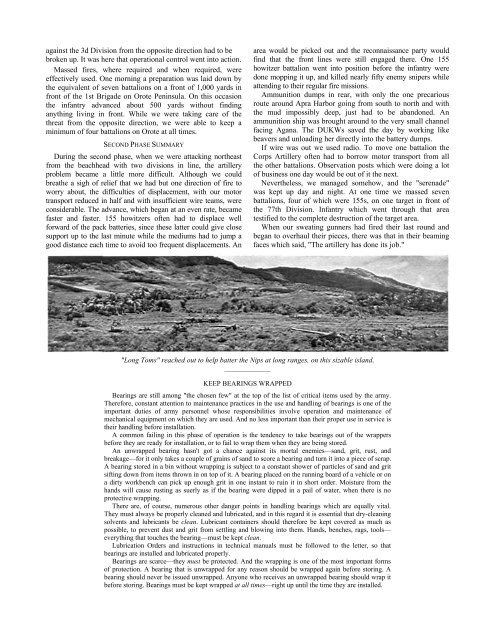the field artillery journal - Fort Sill - U.S. Army
the field artillery journal - Fort Sill - U.S. Army
the field artillery journal - Fort Sill - U.S. Army
You also want an ePaper? Increase the reach of your titles
YUMPU automatically turns print PDFs into web optimized ePapers that Google loves.
against <strong>the</strong> 3d Division from <strong>the</strong> opposite direction had to be<br />
broken up. It was here that operational control went into action.<br />
Massed fires, where required and when required, were<br />
effectively used. One morning a preparation was laid down by<br />
<strong>the</strong> equivalent of seven battalions on a front of 1,000 yards in<br />
front of <strong>the</strong> 1st Brigade on Orote Peninsula. On this occasion<br />
<strong>the</strong> infantry advanced about 500 yards without finding<br />
anything living in front. While we were taking care of <strong>the</strong><br />
threat from <strong>the</strong> opposite direction, we were able to keep a<br />
minimum of four battalions on Orote at all times.<br />
SECOND PHASE SUMMARY<br />
During <strong>the</strong> second phase, when we were attacking nor<strong>the</strong>ast<br />
from <strong>the</strong> beachhead with two divisions in line, <strong>the</strong> <strong>artillery</strong><br />
problem became a little more difficult. Although we could<br />
brea<strong>the</strong> a sigh of relief that we had but one direction of fire to<br />
worry about, <strong>the</strong> difficulties of displacement, with our motor<br />
transport reduced in half and with insufficient wire teams, were<br />
considerable. The advance, which began at an even rate, became<br />
faster and faster. 155 howitzers often had to displace well<br />
forward of <strong>the</strong> pack batteries, since <strong>the</strong>se latter could give close<br />
support up to <strong>the</strong> last minute while <strong>the</strong> mediums had to jump a<br />
good distance each time to avoid too frequent displacements. An<br />
area would be picked out and <strong>the</strong> reconnaissance party would<br />
find that <strong>the</strong> front lines were still engaged <strong>the</strong>re. One 155<br />
howitzer battalion went into position before <strong>the</strong> infantry were<br />
done mopping it up, and killed nearly fifty enemy snipers while<br />
attending to <strong>the</strong>ir regular fire missions.<br />
Ammunition dumps in rear, with only <strong>the</strong> one precarious<br />
route around Apra Harbor going from south to north and with<br />
<strong>the</strong> mud impossibly deep, just had to be abandoned. An<br />
ammunition ship was brought around to <strong>the</strong> very small channel<br />
facing Agana. The DUKWs saved <strong>the</strong> day by working like<br />
beavers and unloading her directly into <strong>the</strong> battery dumps.<br />
If wire was out we used radio. To move one battalion <strong>the</strong><br />
Corps Artillery often had to borrow motor transport from all<br />
<strong>the</strong> o<strong>the</strong>r battalions. Observation posts which were doing a lot<br />
of business one day would be out of it <strong>the</strong> next.<br />
Never<strong>the</strong>less, we managed somehow, and <strong>the</strong> "serenade"<br />
was kept up day and night. At one time we massed seven<br />
battalions, four of which were 155s, on one target in front of<br />
<strong>the</strong> 77th Division. Infantry which went through that area<br />
testified to <strong>the</strong> complete destruction of <strong>the</strong> target area.<br />
When our sweating gunners had fired <strong>the</strong>ir last round and<br />
began to overhaul <strong>the</strong>ir pieces, <strong>the</strong>re was that in <strong>the</strong>ir beaming<br />
faces which said, "The <strong>artillery</strong> has done its job."<br />
"Long Toms" reached out to help batter <strong>the</strong> Nips at long ranges, on this sizable island.<br />
——————<br />
KEEP BEARINGS WRAPPED<br />
Bearings are still among "<strong>the</strong> chosen few" at <strong>the</strong> top of <strong>the</strong> list of critical items used by <strong>the</strong> army.<br />
Therefore, constant attention to maintenance practices in <strong>the</strong> use and handling of bearings is one of <strong>the</strong><br />
important duties of army personnel whose responsibilities involve operation and maintenance of<br />
mechanical equipment on which <strong>the</strong>y are used. And no less important than <strong>the</strong>ir proper use in service is<br />
<strong>the</strong>ir handling before installation.<br />
A common failing in this phase of operation is <strong>the</strong> tendency to take bearings out of <strong>the</strong> wrappers<br />
before <strong>the</strong>y are ready for installation, or to fail to wrap <strong>the</strong>m when <strong>the</strong>y are being stored.<br />
An unwrapped bearing hasn't got a chance against its mortal enemies—sand, grit, rust, and<br />
breakage—for it only takes a couple of grains of sand to score a bearing and turn it into a piece of scrap.<br />
A bearing stored in a bin without wrapping is subject to a constant shower of particles of sand and grit<br />
sifting down from items thrown in on top of it. A bearing placed on <strong>the</strong> running board of a vehicle or on<br />
a dirty workbench can pick up enough grit in one instant to ruin it in short order. Moisture from <strong>the</strong><br />
hands will cause rusting as suerly as if <strong>the</strong> bearing were dipped in a pail of water, when <strong>the</strong>re is no<br />
protective wrapping.<br />
There are, of course, numerous o<strong>the</strong>r danger points in handling bearings which are equally vital.<br />
They must always be properly cleaned and lubricated, and in this regard it is essential that dry-cleaning<br />
solvents and lubricants be clean. Lubricant containers should <strong>the</strong>refore be kept covered as much as<br />
possible, to prevent dust and grit from settling and blowing into <strong>the</strong>m. Hands, benches, rags, tools—<br />
everything that touches <strong>the</strong> bearing—must be kept clean.<br />
Lubrication Orders and instructions in technical manuals must be followed to <strong>the</strong> letter, so that<br />
bearings are installed and lubricated properly.<br />
Bearings are scarce—<strong>the</strong>y must be protected. And <strong>the</strong> wrapping is one of <strong>the</strong> most important forms<br />
of protection. A bearing that is unwrapped for any reason should be wrapped again before storing. A<br />
bearing should never be issued unwrapped. Anyone who receives an unwrapped bearing should wrap it<br />
before storing. Bearings must be kept wrapped at all times—right up until <strong>the</strong> time <strong>the</strong>y are installed.

















